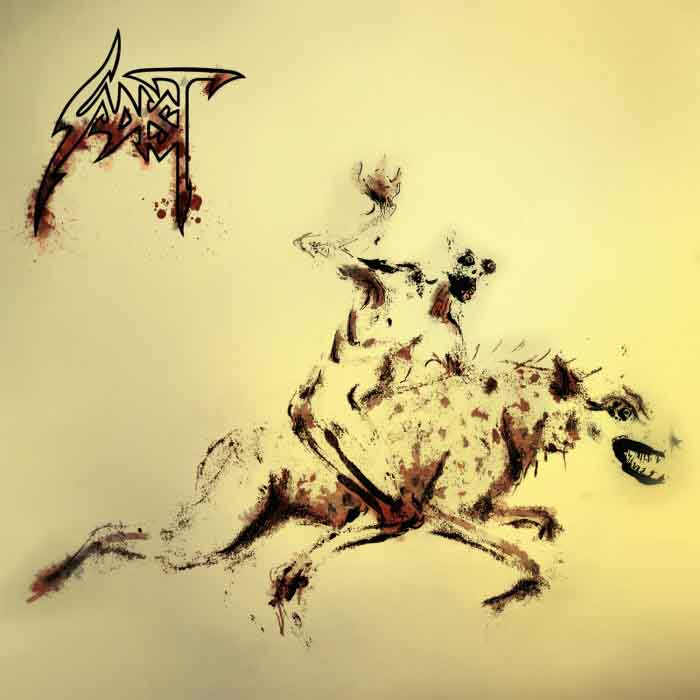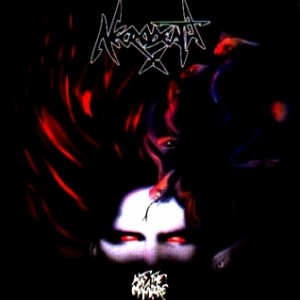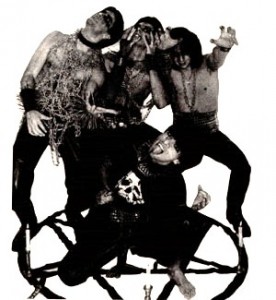
Despite no paucity of topics to possibly review, I took a commentator’s advice (which, for agitprop, I’m going to suggest was inspired by our call to arms) and decided to take a look at the new Sadist album that came out last week and was teased some months ago. Supposedly, Sadist inspired by earlier death metal/jazz fusion bands like Atheist and Pestilence, and I can hear where influences poke through like bones of a half-eaten carcass, but Hyaena also owes some of its genetics to the newer breeds of ‘progressive’ metalcore and djent acts, and therefore walks a fine line between the two.
Hyaena is so thoroughly permeated by its jazz influence that it often sounds like a group of jazz musicians approaching metal, as opposed to the more familiar opposite. There’s certainly a great deal of surface complexity throughout this album. First, it often favors the sort of off-beat syncopation and polyrhythm over 4/4 beat type of percussion popularized by Meshuggah and sons. Secondly, Sadist crams in a great deal of synthesizer and sample presence, including plenty of “tribal” percussion that probably synergizes with the lyrical/visual aspects of this album. What begins to tip me off that this might not just be a mess of pseudo-progressive tropes is Sadist’s adept understanding of modulation and tonality – unlike many bands that play around with it, they actually manage to use this to write more flexible riffs and build some of the changes into their song structures. That is definitely not a mere surface strength.
With further listening, it becomes apparent that Hyaena‘s main strength as an album is its ability to integrate its musical aspects into a coherent whole; as a result, I am willing to forgive some of its weaknesses… which primarily revolve around the fact that this integration sometimes means questionable elements make their way into the album’s sound. For instance, I’m not too fond of some of the sounds used by the keyboardist, but the actual content of the keyboard lines here fits in nicely with the rest of the band, as they end up alternating between providing textural reinforcement and actual counterpoint. This does wonders for the songwriting, as Sadist goes beyond merely using instrumentation to distinguish song sections. It helps that they have two strong sources of musical language that they can pull on for basic elements, but such a potent tool would do little in the hands of a band that failed to integrate those halves.
Needless to say, this puts Sadist at least on a higher level than some of the other metal themed jazz bands. Those with a serious fusion/metalcore/djent allergy will want to stay away, as the ‘heavy’ side of this album seems to lean more core in its aesthetics than not. Still, there is some real depth to this music, even if some of the surface elements seem to chase contemporary trends.
6 CommentsTags: 2015, death metal, hyaena, Italian Death Metal, jazz fusion, progressive rock, sadist

 The sensual Italian attack in Into the Macabre, enveloped by the scents of leather, sweat and blood, is by no accident a bastard brother of the proto-war metal invocations of Morbid Visions and INRI, while the technical details show that the necro-warriors spent years studying the works of Slayer and Destruction. Most of all, Into the Macabre is an opera of rhythm, of intense vocal timings, stampeding blastbeats and onrushing chromatic and speed metal riffs which warp under the extremely analog old tape production into ambient paysages of ghostly frequency, much like the evil and infectious “Equimanthorn” of classic Bathory. Songs like “Necrosadist” seem to have the structure of a grotesque sexual orgy where each consecutive part tops the previous in volume and hysteria, with short breathing spaces in between to capture and organize the listener’s attention. Like the aforementioned Brazilian albums, Into the Macabre is one of the cases where music is about as far from an intellectual exercise as one gets, into the catacombs of a devil/alcohol/glue-possessed teenager’s brain but for the discerning and maniacal old school death metal listener there is no end to the amount of pleasures, revelations and evil moments that make it seem some transcendental guidance indeed dwells at the shrine of the unholy mystic.
The sensual Italian attack in Into the Macabre, enveloped by the scents of leather, sweat and blood, is by no accident a bastard brother of the proto-war metal invocations of Morbid Visions and INRI, while the technical details show that the necro-warriors spent years studying the works of Slayer and Destruction. Most of all, Into the Macabre is an opera of rhythm, of intense vocal timings, stampeding blastbeats and onrushing chromatic and speed metal riffs which warp under the extremely analog old tape production into ambient paysages of ghostly frequency, much like the evil and infectious “Equimanthorn” of classic Bathory. Songs like “Necrosadist” seem to have the structure of a grotesque sexual orgy where each consecutive part tops the previous in volume and hysteria, with short breathing spaces in between to capture and organize the listener’s attention. Like the aforementioned Brazilian albums, Into the Macabre is one of the cases where music is about as far from an intellectual exercise as one gets, into the catacombs of a devil/alcohol/glue-possessed teenager’s brain but for the discerning and maniacal old school death metal listener there is no end to the amount of pleasures, revelations and evil moments that make it seem some transcendental guidance indeed dwells at the shrine of the unholy mystic.
